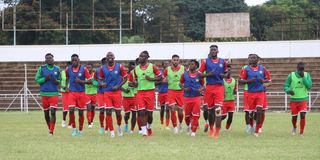Maybe playing away from home is just what Harambee Stars need

Harambee Stars players during a training session in Lilongwe, Malawi ahead of the Four Nations tournament on March 22, 2024.
Football is the world’s most followed sport and every country worth its name in the game proudly has its “home of football”, that venue where dreams have been made and shattered, and national egos bloated like Donald Trump’s or flattened like Kenya Sevens supporters’ when they were relegated from the World Series.
Brazil, that country that gave us Pele, the greatest football player of all time, and the Fifa national team of the 20th century, has the Maracana Stadium. This was once the largest stadium in the world and has famously hosted some of the most memorable World Cup matches including the 1950 final featuring the hosts against Uruguay which had a record (unofficial) 210,000 attendance
England have the magnificent Wembley Stadium, where they won the 1966 World Cup, beating Germany in that controversial final. The proud English even tout Wembley as the world’s “home of football”.
Egypt are the most successful team in Africa with a record seven Afcon titles. Their theatre of dreams is the majestic Cairo International Stadium, one of Africa’s biggest. I was at that edifice, jam-packed with screaming Pharoah fans, as Egypt defeated a Didier Drogba and Kolo Toure-powered Cote d’Ivoire in the final of the 2006 Afcon.
Bukhungu Stadium
What about Kenya? Some writers reckon that the home of Kenyan football is Bukhungu Stadium where the first match that could qualify as an international was held in Kenya.
This was around 1934 when a North Nyanza side hammered top English side Remington 3-0 in front of a huge crowd. But the tiny, now under renovation Bukhungu has never hosted a full, Fifa international fixture because of its inferior status.
The home of Kenyan football would be either Moi International Sports Centre (MISC) or Nyayo National Stadium depending on your persuasion.
By my estimation, MISC, Kenya’s grandest sports arena, sits comfortably as the home of Harambee Stars.
Who will forget the final of the 1987 All Africa Games football pitting an exciting Harambee Stars against Egypt at a full capacity MISC on August 12 of that year?
It was the first time that a football match in the country had attracted a crowd of 60,000 plus.
“Watoto wa nyumbani” Harambee Stars again attracted a capacity crowd on January 12, 1997, when a star-studded Nigeria’s Super Eagles featuring Augustine JJ Okocha, Nwanko Kanu, Sunday Oliseh et al came calling in a 1998 World Cup qualifier.
Kenya gallantly fought to a 1-1 draw.
I will never forget the day Kenya booked a ticket to the 2004 Africa Cup of Nations after 12 agonizing years out.
The country needed to win against Cape Verde at MISC on July 5, 2023, to guarantee passage to the African finals in Tunisia.
As is wont with the federation, official attendance figures were not given, but I reckon the attendance was well beyond 60,000.
The stadium, with yours truly in attendance, first as a sports journalist at work, and second, as a Kenyan patriot, dreaming of Afcon qualification, raptured into wild celebrations when an in-form Dennis Oliech blasted home the only goal of the match in the 85th minute.
I remember being hit by a water bottle filled with unprintable stuff, launched from high up on the stands, as ecstatic fans went berserk, in a way only the beautiful game can do to someone.
You see, the federation had sold out tickets and there was no space for journalists, forcing the organisers to unceremoniously huddle them on the running track behind the team benches.
Several journalists were hit, burying any notion I may have had that I was being targeted.
Was this job worth it, I thought as I also wildly celebrated the goal while dodging incoming missiles? You can thus understand why Kasarani and this particular game is etched in my memories.
The MISC pitch, when at its best, particularly in the 2000s when Sam Mwai was the CEO of Stadia Kenya, is easily Kenya’s best football playing surface.
It is thus unfortunate that at this time when the country is dreaming of qualifying for the World Cup and creating sweet national memories, Harambee Stars cannot play at home.
Civil strife
The country is not at war or undergoing any civil strife to be denied this inalienable international football right. The reason is simple.
MISC and Nyayo Stadium, banned by Fifa from hosting international matches, will also be closed for renovations when Kenya plays their 2026 World Cup home qualifying matches against Burundi on June 3 and Cote d’Ivoire seven days later.
Football Kenya Federation have not officially announced where these home fixtures will be played but the grapevine is rife on where the venue will be.
The federation considered Egypt and Tanzania as options before settling for Malawi.
Why not within the region where Kenyans can travel quickly by road or air to cheer their favourite football team? Why not the USA or the UK, which, between them, host the highest number of Kenyan immigrants at over 500,000?
But the choice of Malawi could prove a stroke of genius. Harambee Stars triumphed there in March, beating hosts Malawi 4-0, and Zimbabwe 3-1 to win a four nations’ tournament.
Remember also, Kenya effortlessly crushed Seychelles 5-0 in an away World Cup qualifier on November 20, last year in Abidjan.
Maybe playing away could be a good thing for Kenya.





